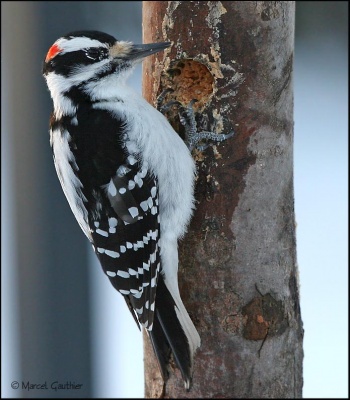
Photo © by digishooter
Wofford Heights, Kern Co., California, USA, 28 November 2009
- Dryobates villosus
Leuconotopicus villosus
Identification

Photo © by Marcel Gauthier
Saint-Jean-sur-Richelieu, Quebec, Canada, 25 November 2005
16·5–26 cm (6½-10¼ in)
Males have a red patch on the back of the head.
Females lack this red patch.
Juvenile and second year birds have red feathers in the crown.
The male usually has a more extensive covering of red feathers than the female.
Variation
White on especially underparts can be replaced by buffy and the white on the back have reduced size in darker forms especially found in Pacific North-West and in Central America
Similar Species
Downy Woodpecker: Hairy Woodpecker has a proportionately larger bill that is about the same length as the head.
Downy Woodpecker has a much smaller, stubbier bill. Hairy Woodpecker lacks dark markings on its outer tail feathers that the Downy has. (This field mark is less useful in the Northwest where darker races of both species exist and these marks are usually present). Hairy usually has a black dividing line at the rear through the red (male) or white area just below the crown, while 99% of Downy Woodpeckers lack that dividing line[2].
Distribution
Nearly universal in North America. In the east north to southern Canada, in the west north to southern Alaska. Also found in the mountains of Mexico and Central America south to Panama.
Taxonomy
Placed in genus Leuconotopicus by Gill and Donsker. Formerly in Picoides
Subspecies

Photo © by digishooter
Wofford Heights, Kern Co., California, USA, July 2009
There are 15 subspecies[1]:
- D. v. septentrionalis: Western North America (Alaska to northern New Mexico)
- D. v. villosus: Eastern North Dakota to southern Quebec, Nova Scotia, central Texas, Missouri, Virginia
- D. v. terraenovae: Newfoundland
- D. v. sitkensis: Coastal south-eastern Alaska and northern British Columbia
- D. v. picoideus: Haida Gwaii (British Columbia)
- D. v. harrisi: Coastal southern British Columbia to north-western California
- D. v. audubonii: Southern Illinois to south-eastern Virginia, eastern Texas and Gulf Coast
- D. v. hyloscopus: Western California to northern Baja California
- D. v. orius: Cascade Mountains of British Columbia to south-eastern California and western Texas
- D. v. icastus: South-eastern Arizona and New Mexico through western Mexico to Jalisco
- D. v. jardinii: Central and eastern Mexico to Jalisco, Guerrero and Oaxaca
- D. v. sanctorum: Southern Mexico (Chiapas) to Guatemala
- D. v. piger: Northern Bahamas (Abaco, Mores and Grand Bahama)
- D. v. maynardi: Southern Bahamas (Andros and New Providence)
- D. v. extimus: eastern Costa Rica and western Panama
Habitat
A variety of forests (particularly pine), woodlands and suburban gardens.
Behaviour
Diet
Diet consists of insects (mostly wood-boring beetles, berries and acorns. Will also visit bird feeders for peanuts, suet, black oil sunflower seeds.
The southern populations (Costa Rica and Panama) seems to find insects in moss and other epiphytes, sometimes on very thin branches[4].
Breeding
Both sexes excavate a cavity in live wood. The clutch of 3 to 6 eggs are incubated by both adults. Males brood the eggs at night, and females during the day. Eggs hatch in about 14 days, and young birds leave the cavity in about a month. Young birds will accompany adults for the first few weeks before they become independent.
Vocalisation
Descending rattle: kekekekekekeke... A bit lower than Downy Woodpecker (but very similar).
References
- Clements, J. F., T. S. Schulenberg, M. J. Iliff, S. M. Billerman, T. A. Fredericks, J. A. Gerbracht, D. Lepage, B. L. Sullivan, and C. L. Wood. 2021. The eBird/Clements checklist of Birds of the World: v2021. Downloaded from https://www.birds.cornell.edu/clementschecklist/download/
- Sibley describing a clue for identification
- Winkler, H., Christie, D.A. & Kirwan, G.M. (2020). Hairy Woodpecker (Leuconotopicus villosus). In: del Hoyo, J., Elliott, A., Sargatal, J., Christie, D.A. & de Juana, E. (eds.). Handbook of the Birds of the World Alive. Lynx Edicions, Barcelona. (retrieved from https://www.hbw.com/node/56237 on 28 April 2020).
- Birdforum member observations
- Jackson, J. A., H. R. Ouellet, and B. J. Jackson (2020). Hairy Woodpecker (Dryobates villosus), version 1.0. In Birds of the World (P. G. Rodewald, Editor). Cornell Lab of Ornithology, Ithaca, NY, USA. https://doi.org/10.2173/bow.haiwoo.01
Recommended Citation
- BirdForum Opus contributors. (2025) Hairy Woodpecker. In: BirdForum, the forum for wild birds and birding. Retrieved 16 May 2025 from https://www.birdforum.net/opus/Hairy_Woodpecker
External Links
GSearch checked for 2020 platform.




